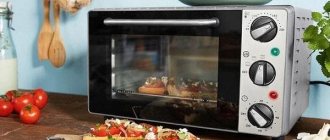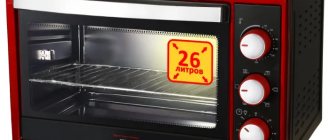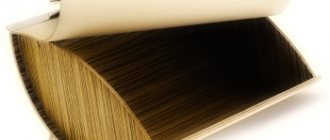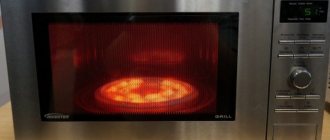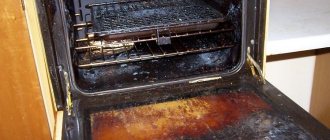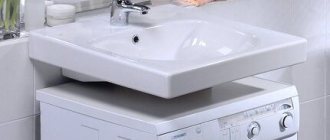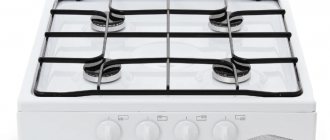Microwave oven and mini-oven: what is common and what is the difference
Housewives have known the microwave for many years, but the mini-oven appeared on the household appliances market not so long ago. The mini-oven performs the functions of an oven, toaster, grill and microwave, as it is capable of defrosting food and heating food.
Similarities
The devices are similar in appearance. On the front side there is a glazed door and a control panel. They are compact and fit on the kitchen counter due to their small dimensions - within 30x50x40 cm. The size of the internal chamber is from 10 to 40 liters. The microwave and mini-oven (or electric oven is its second name) operate from the mains.
There is a similarity in electricity consumption: for a mini-oven it is 1.5-2 kV, for a microwave oven it is from 1 to 2 kV. These figures refer to devices with similar standard functionality and a price in the range of 5,000-10,000 rubles. As the chamber volume increases and additional functions are available, the energy consumption of the devices increases.
The type of furnace control can be mechanical or electronic. The advantage of a mechanical one is its simplicity and reliability, and an electronic one is an expanded choice of cooking methods.
The internal coating of the microwave and mini-oven chambers is made of enamel, stainless steel or ceramics. It is important that it can withstand high temperatures and is easy to clean.
Both devices are equipped with an internal chamber light, a tray for collecting crumbs and fat (in a microwave, this function is performed by a rotating plate), and a timer.
More expensive models of mini-ovens and microwaves have additional modes: convection, grill, spit. The energy consumption and price of such devices are significantly higher.
Differences
How is a microwave oven different from an electric oven? The main difference lies in the principle of operation. A mini-oven, like a traditional electric oven, cooks food using the heat generated by thermal heating elements - heating elements. The oven can reach temperatures from 30 to 250°C, baking the dish evenly.
A microwave oven cooks using ultra-high frequency (microwave) radiation, which is generated by a magnetron. Under the influence of microwaves, the water molecules present in any food begin to move, as a result of which the water boils, and the food in which it is contained rapidly heats up. Heating does not occur gradually and not from the outside in, as happens in a conventional oven, but throughout the entire product at once. In this case, the temperature does not rise above the boiling point - 100°C.
In most cases, a microwave oven is used to heat and defrost food. The main purpose of a mini-oven is cooking.
Which is better: microwave or mini-oven?
Let's summarize which kitchen appliances to give preference to. In fact, both devices have a lot in common - both do not take up much space, cook relatively quickly and are easy to operate. The list of dishes is quite similar, however, the significant difference between a mini-oven and a microwave is that the operating technology does not allow the microwave to bake.
And baking is the basis of any home. Therefore, a microwave oven is an excellent solution for placement in an office, but for a home kitchen, regardless of its size, choosing a mini-oven will be suitable. In addition to baking, it will give you the opportunity to enjoy the taste of natural food. If you use the oven frequently, it will also be more profitable to buy a mini-oven.
Need to know! A mini oven cooks food more efficiently than a microwave, which is primarily designed to heat food.
In addition, the roaster can save space in the kitchen by replacing several appliances at once.
Read more: Rating of the best face creams
Those concerned about safety should also consider a compact oven.
If it breaks, it will immediately stop working, while microwaves can enter the environment through minor damage to the housing.
Microwave Oven Features
The main advantage of a microwave is its speed. 1-2 minutes is enough to heat up the finished dish. The plate will remain cool, and if it warms up, it will only be due to the temperature of the food itself. In the microwave you can cook oatmeal, quickly bake vegetables, and prepare some other simple dishes. The porridge will be cooked in a deep bowl in 2-3 minutes, and the omelette will be baked in a plate in 5 minutes. Using a microwave reduces the time for cooking and heating food and, as a result, energy costs.
But this device also has a significant disadvantage. Cooking in a microwave oven occurs on the principle of internal heating and evaporation - this limits the possible range of dishes. In a budget microwave, the meat will not turn crispy, and you will also not be able to bake a pie.
More complex devices are designed for frying and baking - combination microwave ovens, equipped with additional functions.
Reference. The following manufacturers offer high-quality microwave ovens: Samsung, Gorenje, LG, Hotpoint-Ariston, Redmond, Daewoo, Supra, BBK.
Varieties
Based on the operating principle of microwave ovens, they can be divided into several groups:
- Microwave, operating due to microwave radiation. Most often used for defrosting and heating ready meals. These models are the most popular and enjoy the most consistent consumer demand.
- A microwave oven with grill is a combined device, additionally equipped with heat emitters (quartz lamps or tubular heating elements). Microwave with grill is aimed at a more complex menu. You can fry meat with a golden brown crust, fish, and French fries in it.
- Convection microwaves . In such ovens, streams of hot air, pumped using special fans, are directed at the dish being prepared. Circulation of hot air promotes uniform baking of the product. If in a simple microwave the temperature does not rise above 100°C, then in an oven with convection mode it can reach up to 250°C. Such a microwave oven can replace an oven. Models with a convection function are much more expensive than a conventional microwave, their dimensions are larger, and their energy consumption is significantly higher.
- Inverter microwave. Microwave of the latest generation. The peculiarity of this device is that the radiation from its magnetron is controlled electronically. In a conventional microwave, the magnetron operates with constant power; its periodic turning off and turning on leads to a harsh effect of the emitter on food and surges in electricity in the network. Inverter ovens are more economical, but what is more important is that in them microwaves have a gentler effect on the product being processed.
- Multifunctional microwave ovens. The most expensive microwaves with grill and convection have various built-in programs, for example, defrosting followed by cooking, remember frequently used recipes, and can be programmed to prepare dishes according to their own “branded” recipes. The price of such stoves is from 20,000 to 40,000 rubles.
Advantages
Advantages of a microwave oven:
- high speed of cooking and heating food;
- the ability to cook without adding oil and fat, which is important for adherents of a healthy diet;
- preservation of vitamins and microelements, since food is heated quickly and is limited to 100°C;
- absence of food odors, which is important when using a microwave, for example, in the office;
- the ability to heat food directly in the plate, which is convenient and saves effort and time on washing dishes;
- compact size and nice design, the ability to be built into kitchen furniture or mounted on a bracket, which is important in small spaces.
Flaws
Microwave radiation. There is no objective data proving that microwaves are harmful to human health. However, an increasing number of people are refusing to purchase this device in favor of more environmentally friendly devices. And some people simply don’t like the taste of dishes cooked in a microwave oven; they consider it “artificial.”
When using a microwave, the following precautions should be taken:
- Do not use metal utensils or utensils coated with metal.
- When using plastic utensils, you should be guided by the “microwave” marking or the three-wave icon.
- You cannot heat liquids in closed containers, boil eggs, and peeled vegetables and sausages must first be pierced.
- It is forbidden to turn on an empty microwave.
- You should heat the water with caution, because if it overheats, it can boil almost instantly even from careless movement.
What to choose: oven or stovetop with oven
Having a modern oven or stove with a good oven in the kitchen is a matter of principle for those who love to eat, cook and receive guests. It would seem that there is no difference in what you use to create culinary masterpieces, however, if you are fond of cooking, it is better to take care of a technique that always produces delicious dishes and which will never let you down, even if you are aiming for a very complex recipe.
It depends on the size of the kitchen and your financial capabilities, but first you need to understand the difference between an oven and a stove with an oven.
- The oven is part of the stove and is inseparable from its hob, while a modern oven, on the contrary, is independent of it and therefore can be built into kitchen furniture. At the same time, the autonomous hob can be located anywhere - even at the other end of the kitchen.
- Many people place the oven at waist level so as not to bend over to check the readiness of the dish - this makes the cooking process pleasant and comfortable.
- Controlling a stovetop is much easier than controlling an oven because the oven has fewer functions.
- Another difference is that the entire oven space is maintained at the same temperature, while in the oven you can cook several dishes at the same time at different temperatures.
- Thanks to the convection function, food in the oven cooks faster and turns out more appetizing and tasty.
- The oven, spacious and multifunctional, is suitable for those who have to cook for a large family and often receive guests.
In other words, if you are a gourmet and an esthete, and cooking is your natural element, it’s time to think about how to choose an oven, since a regular stove with oven will not be able to realize all your culinary dreams and fantasies.
It is difficult to determine which oven is better, since each of them meets certain consumer requirements. The cost of the equipment depends on the functionality; the more options an oven has, the more popular and in demand it is among housewives.
So, what do we know about ovens?
- Baking and roasting cabinets are equipped with an external cooling system and a heat-insulated door, so the kitchen furniture in which they are built will not be damaged.
- Thanks to the pull-out cart, you can check the readiness of the dish without removing it from the oven.
- The presence of a temperature sensor (temperature probe), the tip of which is placed into the meat before cooking, improves the degree of frying, and as soon as the meat is ready, the temperature probe sends a signal to turn off the oven.
- An electronic control panel with various programs and a memory function allows you to fully control food preparation and automate this process to the maximum.
- The best built-in ovens are electric, as they have more modes and capabilities and are often equipped with an electronic programming option with food recipes embedded in the program. I chose a recipe, pressed a button and you can go about your business - the smart oven will do everything itself.
- The self-cleaning enamel coating, to which dirt and fumes do not stick, simplifies maintenance of the oven - you don’t have to wash it, just wipe it lightly.
- Hydrolysis and pyrolysis cleaning of the oven involves removing dirt using steam and heating to a temperature of 300 degrees, and a special filter on the back wall of the oven absorbs odors and grease.
- The width of the ovens is from 60 to 120 cm, and several ways of opening the door and different colors make this kitchen unit able to fit into any interior.
Read more: TOP 10 resorts in the Krasnodar Territory
So before choosing a stove or oven, think about the purpose for which you are purchasing the appliance and how passionate you are about the culinary arts.
The advantage of a roaster over an oven is not only its compactness, but also its versatility.
For reference! The mini-oven copes not only with baking food, but also with defrosting and heating it.
And the presence of automatic programs in the device makes cooking as simple as possible, even for novice cooks.
The disadvantages of roasters are mainly related to the design features of individual models.
In order not to encounter negative aspects during the operation of the device, you should choose products from well-known manufacturers.
Features of the mini oven
In a mini-oven you can bake cakes, pies and cookies, bake meat and fish, and stew vegetables. That is, cook the same dishes as in a conventional oven, only faster and more economically.
The volume of a standard oven is 50-70 liters, power consumption ranges from 2.5-4 kW, and the heating time to 180°C is 10-15 minutes. To maintain the desired temperature during baking, a sufficient amount of energy is required. Everyday meals are usually small and disproportionate to the volume of the chamber. It turns out that most of the oven's energy is wasted irrationally.
Due to its small volume, a mini-oven can heat up faster and maintain a high temperature longer. For example, a stove with quartz heaters reaches a temperature of 200°C in 2-3 minutes.
The advantage of a mini oven is that its performance is comparable to a full-size oven, and its energy consumption is lower.
The larger the volume of the oven, the more power is required to heat it up. The most popular models are those with a power of 1000-1500 kW.
Reference. Mini-ovens from the following manufacturers are popular: Bork, Delonghi, Simfer, Kitfort, Rommelsbacher, Dex, Galaxy, Steba, Gemlux, GFgril Breakfast Bar.
Modes
In a mini-oven, food is cooked under the influence of heat emitted by heating elements located in the upper and lower parts of the chamber. In a number of models, heating elements are replaced with quartz lamps. Such ovens heat up to the desired temperature faster.
The standard operating mode involves top or bottom heating or simultaneous heating of two elements. Additional modes: cooking pizza, single-sided or double-sided toast, baking, reheating, quick heating, defrosting and others.
Some models are equipped with convection and grill functions. Most ovens have a spit, a metal pin on which vegetables or meat are placed.
Regardless of size, all mini-ovens operate the same way - bake and stew. The only difference is the number of servings. A compact electric oven can fully satisfy the needs of an average family of 3-5 people.
Advantages
A mini-oven can replace a whole range of kitchen appliances and has many advantages:
- small size - suitable for a small kitchen, cottage, rented apartment, dormitory;
- the small volume of the chamber heats up faster and retains heat longer compared to a stationary oven;
- traditional, natural way of cooking, in which everything is delicious;
- the ability to quickly heat up dishes with a crispy crust;
- ease of use;
- an impressive list of dishes to prepare;
- profitability - low price and lower energy consumption compared to an oven;
- possibility of cooking in almost any container: metal, ceramics, clay, silicone, fireproof glass.
Flaws
With all its undeniable advantages, a mini-oven is a smaller and simplified oven model. Its two main advantages - its small size and a full range of oven functions - led to the presence of some disadvantages.
The body of the electric furnace heats up, and you can get burned on the walls and glass.
The tempered glass of the door (single in budget models, double in more expensive ones) also heats up. For comparison, the door of a stationary oven has four layers of protective glass.
Attention! If there are small children in the house, you need to make sure that they do not approach or touch the appliance while the mini-oven is operating.
Can an electric oven be used as a microwave?
More and more people, fearing the negative effects of microwaves, are looking for a replacement microwave oven.
A mini-oven, like a microwave, can be used to heat and defrost food. Defrosting in an electric oven occurs almost naturally under the influence of low temperatures (30-40°C), as if the product was simply placed in a warm place.
When heating ready-made dishes in an electric oven, the product is evenly heated from below, above and on the sides. Overdrying of food, which is typical for heating in the microwave, is excluded. You can make a hot sandwich in minutes. It’s more difficult with liquids: you can’t heat up the soup and serve it on the table in the same bowl. You also won't be able to warm up a mug of cold milk without heating the pan.
Myths about the microwave. There is an opinion that microwaves can change the structure of water and food and turn beneficial substances into carcinogens. However, microwave energy is not enough to break chemical bonds. In addition, it is known that water (except for frozen water) does not have a constant structure.
